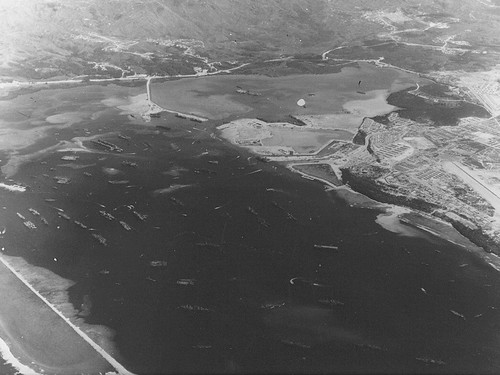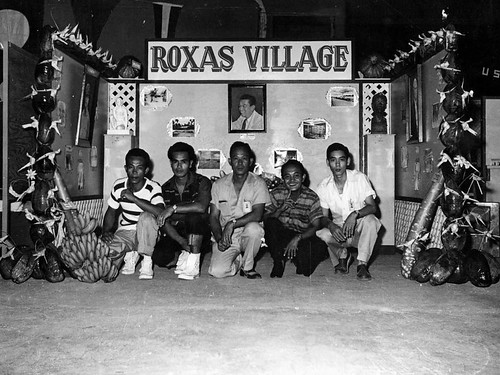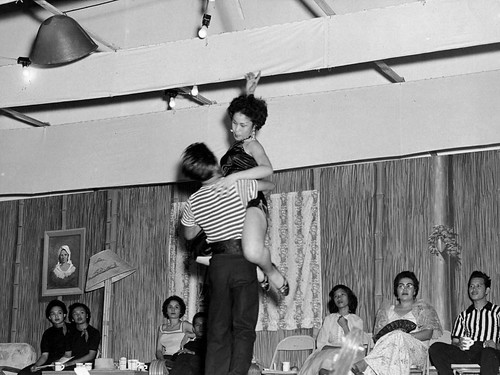Filipino Migration to Guam 1945 – 1975
Immediate Post-War Migration
With a long and storied history of Filipino-CHamoru interaction in Guam, it is surprising to note that since the end of the Second World War in 1944, the contemporary Filipino record in the western Pacific has been largely ignored.
It is only now—more than 70 years later—that Pacific historians and economists are beginning to piece together the complex puzzle of what these pioneers of labor have offered to the region in general, and to Guam, specifically.
A number of significant changes occurred to the war-torn island a year after V-J Day. The highest priority was to reconstruct Guam as a strategic forward base to monitor Asian decolonization. In February 1946, the Construction Contracts Marianas, a military office designated to construct all military facilities in the Marianas, was created as a joint venture with civilian construction companies. In addition to constructing the Apra Harbor breakwater, their task was to provide engineering services for basic infrastructure needs (water, power, road systems, and healthcare) and to rebuild the island’s capital, Hagåtña—all to the tune of $379.2 million. Consequently, Guam was destined to become the largest US military base west of Pearl Harbor, Hawai`i.
To say that military and off-island construction companies dictated economic conditions on Guam is an understatement. Although civil liberties were restored with the May 1946 lifting of martial law, the military deemed that qualified local manpower demands were insufficient, primarily because CHamorus were busy putting their own shattered lives back together.
To resolve what the military believed to be a chronic shortage of labor, the US Embassy in Manila and the newly independent government of the Republic of the Philippines in May 1947 negotiated an agreement for “the recruitment and employment of Philippine citizens by the US military forces and its contractors in the Pacific, including Guam.”
Following the 1947 agreement, Brown-Pacific-Maxon Construction Company (BPM) and Luzon Stevedoring Corporation (Luzdelco) were authorized to import Filipino labor from Manila and its surrounding provinces to provide support construction services for Andersen Air Force Base in Yigo. The Guam Naval Supply Depot permitted the Marianas Stevedoring and Development Company (Masdelco) to contract employment from Iloilo and other Visayan islands of the central Philippines. Masdelco was a subsidiary of Luzdelco and based in the Hågat–Sånta Rita-Sumai area of southern Guam. The initial bulk of Filipino laborers were recruited from Iloilo. All had to undergo rigorous clearance and background checks by the US Navy and Federal Bureau of Investigation before being admitted to Guam on a one-year labor contract subject to renewal for up to three years.
Thousands of skilled and unskilled Filipino laborers eagerly migrated to Guam in 1947. After all, their country had been devastated by four years of war and, in the early years following independence, was plagued by a lack of financial opportunities. Even if laborers made the prevailing 30-50 cents per hour wage on Guam, it was more money than what could have been made in their homeland. Additionally, laborers were provided airfare, housing, and food.
By the mid-1950s, BPM employed more than 17,000 laborers in makeshift camps, which later became cities, then disappeared upon completion of the contract. Such camp-cities included Marbo (later Magsaysay Village located opposite a shopping complex in Yigo); Camp Quezon, a large, rambling site near the present-day University of Guam; and, Camp Roxas, which housed Masdelco-recruited laborers near Naval Station in Sånta Rita-Sumai.
The single largest camp-city was Camp Roxas—its population totaled 7,000 male laborers and one female—that contained miles of barracks, a 15-acre beachfront, an open-air movie theater, post office, sports facilities, and a bakery. Surrounding the camp’s perimeter were miles of cyclone fence topped with barbed wire. Countless others, though, lived in less-than-idyll conditions and suffered horrific abuses.
Hardships endured
Despite relatively good living conditions, these stalwart pioneers of labor endured many hardships. Most were up before the crack of dawn. They piled into a convoy of trucks to their site—whether it was building wood-and-tin homes for civilians or constructing new military buildings on the various Navy or Air Force bases—and then worked 12 hours in the equatorial sun before heading back to camp. Some were beaten, others threatened if they under-performed or talked back to superiors. The threat of repatriation loomed heavily over each laborer; most did what they were told without confrontation. Opportunistic laborers did manage to strike friendships with the locals and wound up securing part-time work as mechanics, launderers, and gardeners. Still, others tried to marry local women to escape the tedium of camp life and establish a foundation for American citizenship, but rigidly enforced laws curtailed these unions.
As the 1940s gave way to the 1950s, the world was quickly engulfed in the Cold War tension between the United States and the Soviet Union. Consequently, strategic places, like Guam, became more important to American security. Filipino labor recruitment continued unabated to shore up military installations. A series of unexpected turn of events stemming from Washington, DC permanently transformed Guam’s political and social landscape—the 1950 Organic Act and, two years later, the Immigration and Nationality Act.
Guam was considered politically mature relative to the US-administered Trust Territory of the Pacific Islands. The Organic Act removed the US Navy as administrative authority and replaced it with the Department of Interior. Residents were granted limited self-government and American citizenship (the right to vote for the president of the US has yet to be granted). Congress appointed a civilian governor for the first time, but the US military still controlled 42 percent of Guam’s land by right of eminent domain.
By virtue of his newfound authority, the governor was able to grant permits to private merchants and others in need of labor to import Filipinos (upon executing a contract for one year and posting a bond guaranteeing departure). Companies taking advantage of the new ruling included J&G Construction Company, Tommy’s Bakery, and other defense contractors.
Two years later, the tome-like Immigration and Nationality Act authorized the Immigration and Naturalization Service to have control over immigration matters. But, given the military’s reluctance to relinquish control, there appeared to be a conflict. The INS argued that Section 307 of the 1952 Act granted them authority, while the military countered with the 1947 exchange of notes between the two governments as the governing authority. The impasse was somewhat compromised on paper as both the US Navy and INS held sway over Filipino labor entrance into Guam.
To effectively manage labor migration, the Act labeled laborers according to a specific visa status. Filipino laborers, and later other Asians migrating to American territories were classified as H-2 temporary laborers. The H-2 provision stated: “(H) An alien having a residence in a foreign country which he has no intention of abandoning … (ii) who is coming temporarily to the US to perform other temporary services or labor if unemployed persons capable of performing such service or labor cannot be found in this country.” Though the bureaucracy was heavy, once completed, migrants were working on American soil.
The Act also did something remarkable—it attempted to define who was an American citizen and who was not. “The Act confers US citizens as of 1 August 1950, on most natives of Guam born after 11 April 1899, and on most inhabitants who had been present on that date and had resided on the island following it.”
This broad-brushed definition meant that Filipino laborers, who had resided on Guam prior to 1950, were given permanent resident status, and a chance to petition the INS to become US citizens. Once a “green card” was issued, a majority of Filipino permanent residents left for Hawai`i and the continental US; few remained on Guam. Those who did remain helped the next batch of H-2 laborers assimilate as efficiently as possible.
The military’s preference for foreign labor was purely economic, and it continually placed pressure on the INS to waive three-year contract restrictions, arguing a reduction in the workforce would cripple the economy. The savings generated by paying lower wages to H-2 workers was enormous, though uncalculated. Moreover, the military bluntly stated that a reduction in the number of Filipino H-2 workers would cripple the economy. The Guam Chamber of Commerce agreed.
Sen. Sablan questioned policies
Given military clout, Philippine nationals continued to arrive at Guam’s shores to serve as contract laborers, causing a stir among CHamoru politicians. James T. Sablan, a senator in the Second Guam Legislature, argued passionately about the increase in local unemployment, discriminatory practices by Brown-Pacific-Maxon, and the potential flood of immigrants that could cause CHamorus to be a minority in their own land.
There is favoritism shown to aliens because not only [were] they (contract laborers) paid less, but also because of their alien status (subject to deportation for any infraction), they [were] submissive to their employers.
Sablan was not the lone voice of dissent, but the military, along with defense contractors and private businesses, stifled the legislators’ pleas.
Typhoons and war (1960s-1970s)
The economic slump Guam faced in the late 1950s temporarily curtailed the need for H-2 laborers. Many were repatriated, while others hid from INS agents, only to resurface during the 1988 amnesty program. Guam would see several more labor cycles—immediately following the devastation of typhoons Karen (1962) and Olive (1963); during the height of American involvement in Vietnam, 1968 – 1973; and, when tourism became the economic engine of the island in the early 1970s—before Filipinos were replaced by other Asian contract workers.
In 1960, an economic recession hit the US and its territories. The number of contract workers reached its lowest ebb—with less than 1,000—by the dawn of Typhoon Karen in November 1962.
Typhoon Karen made a direct hit over Guam on 11 November 1962, with estimated sustained winds of 150 miles per hour. The mostly wood-and-tin structures and military quonset huts were easily destroyed. Estimated property damage totaled more than $66 million, and President John F. Kennedy declared Guam a disaster area. Governor Manuel L. Guerrero immediately requested 1,500 skilled laborers from the Philippines to come to Guam for a six-month period to rebuild damaged property.
A year later, Typhoon Olive devastated the island, again. Congress enacted Public Law 88-170 “to provide (for the) rehabilitation of Guam through the construction of infrastructure, development, and stimulation of trade and industry and provision of community facilities.” The public law, also known as the Guam Rehabilitation Act, provided $45 million in grants and long-term loans for Guam residents until 1973.
The massive infusion of monies for typhoon-related rehabilitation laid the groundwork for permanent construction of infrastructure, housing, hotels, and military complexes. Adding to this frenzy of construction was the American effort to stymie communist aggression in Vietnam; Andersen Air Force Base served as the launching pad of B-52s against North Vietnam’s regime. Consequently, a continuous and chronic shortage of housing plagued Guam’s residents as military requirements against Vietnam took top priority.
Dededo became a bedroom community of Andersen, and was built mostly by Filipino labor. Its location between Harmon Industrial Park, the hotel area of Tumon, and the Yigo Amusement Park enabled the village to become a sprawling community. Kaiser-Aetna and Black Construction, both of Hawai’i, built 1,500 concrete, typhoon-resistant houses by 1965 in Kaiser I and II; another 1,500 Liguan Terraces houses were completed by 1970. People could afford the $14,000 “house and lot.”
The continued expansion of Guam’s economy by the early 1970s created a severe need for labor, especially since policy-makers touted tourism as the economic engine of the future. Increased federal spending due to the Vietnam War, Japanese investments in tourism, and private construction of housing required the need for temporary laborers. Between 1969 and 1975, Black Construction completed forty-one construction and military-related projects in civil, structural, architectural, plumbing, and mechanical projects totaling $62.7 million.
But, as the Paris Peace Talks ended the hostilities between the US and Vietnam in January 1973, the need for skilled Filipino laborers faded, only to be replaced by the less expensive Korean and Chinese laborer. Most Filipinos had acculturated to Guam’s culture, while others used Guam as a stepping-stone to the US mainland. Considered now by Pacific historians as a major footnote to Guam’s rich history, the Filipino laborer of the 1940s through the 1970s contributed significantly to the island’s growth. Not only had former contract workers and their families successfully assimilated to become Guamanians, their contributions continue to reshape the islandscape.
For further reading
Abella, Domingo. From Indio to Filipino: And Some Historical Works. Manila: M. Romualdez-Abella, 1978.
Agoncillo, Teodoro A., and Milagros C. Guerrero. History of the Filipino People. 5th ed. Quezon City: R.P. Garcia Publishing Company, 1977.
Campbell, Bruce L. “The Filipino Community of Guam (1945-1975).” MA thesis, University of Hawai`i, 1987.





